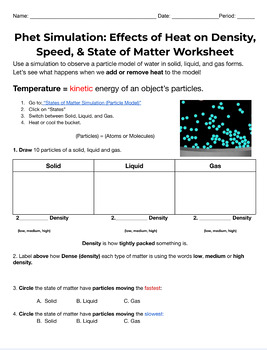Phet Simulation: Effects of Heat on Density, Speed, & State of Matter Worksheet
Kimberly Odenthal
68 Followers
Grade Levels
6th - 8th
Subjects
Resource Type
Standards
NGSSMS-PS3-4
NGSSMS-PS1-4
NGSSMS-PS3-5
Formats Included
- PDF
- Webquests
Pages
3 pages
Kimberly Odenthal
68 Followers
Compatible with Digital Devices
The Teacher-Author has indicated that this resource can be used for device-based learning.
Description
Phet Simulation Worksheet: Effects of Heat on Density, Speed, and State of Matter Worksheet:
Using the Phet Simulation on states of matter, the worksheet will guide students to investigate and answer questions on how heat affects the density and speed of matter in solids, liquids, and gas.
Worksheet used and proven effective in both special education and general education classes.
This worksheet utilizes UDL to address the NGSS:
Heat Transfer:
- NGSS Standard for MS-PS1-4: Heat Transfer:
Core Idea: Matter and Its Interactions- Performance Expectation: Develop a model that predicts and describes changes in particle motion, temperature, and state of a pure substance when thermal energy is added or removed.
Phet States of Matter Simulation website
-Utilizes UDL design
-Word banks
-Visuals
-cloze sentences
-short and long answer questions
-modeling questions
Total Pages
3 pages
Answer Key
N/A
Teaching Duration
N/A
Report this resource to TPT
Reported resources will be reviewed by our team. Report this resource to let us know if this resource violates TPT’s content guidelines.
Standards
to see state-specific standards (only available in the US).
NGSSMS-PS3-4
Plan an investigation to determine the relationships among the energy transferred, the type of matter, the mass, and the change in the average kinetic energy of the particles as measured by the temperature of the sample. Examples of experiments could include comparing final water temperatures after different masses of ice melted in the same volume of water with the same initial temperature, the temperature change of samples of different materials with the same mass as they cool or heat in the environment, or the same material with different masses when a specific amount of energy is added. Assessment does not include calculating the total amount of thermal energy transferred.
NGSSMS-PS1-4
Develop a model that predicts and describes changes in particle motion, temperature, and state of a pure substance when thermal energy is added or removed. Emphasis is on qualitative molecular-level models of solids, liquids, and gases to show that adding or removing thermal energy increases or decreases kinetic energy of the particles until a change of state occurs. Examples of models could include drawings and diagrams. Examples of particles could include molecules or inert atoms. Examples of pure substances could include water, carbon dioxide, and helium.
NGSSMS-PS3-5
Construct, use, and present arguments to support the claim that when the kinetic energy of an object changes, energy is transferred to or from the object. Examples of empirical evidence used in arguments could include an inventory or other representation of the energy before and after the transfer in the form of temperature changes or motion of object. Assessment does not include calculations of energy.





